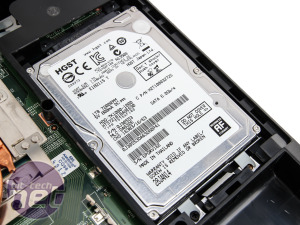
So what does two grand get you with laptops these days? The answer is a fair bit, but as we saw with the move to 1080p screens a few years back, the main issue is cramming enough graphics horsepower in to deal with all those pixels. Higher resolutions are good, but seeing as you need two desktop GTX 780 Ti 3GB's to deal with 4K, the Dominator Pro's 3K monster isn't going to be a lot less forgiving either. In fact, there are over two thirds as many pixels as a triple 1080p setup, which is a lot to ask of any laptop.
The screen itself is an IPS affair and as such has pretty good viewing angles. Coupled with the sharpness on offer, the only real thing you notice is a slight drop in brightness at extreme angles. However, the backlighting wasn't very even and there was also noticeable bleed. These aren't deal breakers but are frustrating slip ups for such a pricey machine.
A Core i7-4800MQ sits at the heart of the Dominator Pro and this 22nm Haswell mobile chip sits roughly mid-table in Intel's current quadcore hyper threaded lineup of mobile CPUs. It sports 6MB of L3 cache and has a clock speed of 2.7GHz, turbo boosting to 3.7GHz and with eight threads available, this should be able to power its way through pretty much aything you throw at it.
The graphics department is clearly key here to deal with the Ultra HD screen and MSI has opted for Nvidia's Kepler KG104-based GeForce GTX 880M 4GB with 1536 stream processors, a 5GHz effective memory speed and basic core speed of 954MHz. It's a similar offering to the GTX 780M, and it is a little disappointing that we don't have a Maxwell based GPU here but Nvidia does claim a 15 per cent performance boost over GTX 780M so all is not lost. There are a number of battery life-enhancing with the most notable being NVIDIA
Battery Boost - a kind of V-Sync for battery life, which targets a frame rate and reduces excess power on components if they're not needed.
There's 16GB of 1,600MHz DDR3, and there are two free slots inside too, not that you'll need to upgrade this in the foreseeable future anyway. Storage is an interesting arrangement, made up of a single 1TB Hitachi 7K1000 plus three Toshiba THNH128GMCT SSDs in RAID 0 giving a formatted OS volume of 356GB. It's undoubtedly going to be rapid but given the option we'd prefer a single 500GB mSATA SSD, which would probably be cheaper too. Still, if willy waving appeals to you, triple SSDs in RAID 0 likely will too.
The cooling arrangement is fairly typical, with three heatpipes spanning large heatsinks on the CPU and GPU plus a single fan drawing air in the back and shoving it out the side. This does spin up to a fairly audible level but you have to put the GPU or CPU under heavy load for it to do so. It's otherwise fairly quiet.
The screen itself is an IPS affair and as such has pretty good viewing angles. Coupled with the sharpness on offer, the only real thing you notice is a slight drop in brightness at extreme angles. However, the backlighting wasn't very even and there was also noticeable bleed. These aren't deal breakers but are frustrating slip ups for such a pricey machine.
Click to enlarge
A Core i7-4800MQ sits at the heart of the Dominator Pro and this 22nm Haswell mobile chip sits roughly mid-table in Intel's current quadcore hyper threaded lineup of mobile CPUs. It sports 6MB of L3 cache and has a clock speed of 2.7GHz, turbo boosting to 3.7GHz and with eight threads available, this should be able to power its way through pretty much aything you throw at it.
The graphics department is clearly key here to deal with the Ultra HD screen and MSI has opted for Nvidia's Kepler KG104-based GeForce GTX 880M 4GB with 1536 stream processors, a 5GHz effective memory speed and basic core speed of 954MHz. It's a similar offering to the GTX 780M, and it is a little disappointing that we don't have a Maxwell based GPU here but Nvidia does claim a 15 per cent performance boost over GTX 780M so all is not lost. There are a number of battery life-enhancing with the most notable being NVIDIA
Battery Boost - a kind of V-Sync for battery life, which targets a frame rate and reduces excess power on components if they're not needed.
Click to enlarge
There's 16GB of 1,600MHz DDR3, and there are two free slots inside too, not that you'll need to upgrade this in the foreseeable future anyway. Storage is an interesting arrangement, made up of a single 1TB Hitachi 7K1000 plus three Toshiba THNH128GMCT SSDs in RAID 0 giving a formatted OS volume of 356GB. It's undoubtedly going to be rapid but given the option we'd prefer a single 500GB mSATA SSD, which would probably be cheaper too. Still, if willy waving appeals to you, triple SSDs in RAID 0 likely will too.
Click to enlarge
The cooling arrangement is fairly typical, with three heatpipes spanning large heatsinks on the CPU and GPU plus a single fan drawing air in the back and shoving it out the side. This does spin up to a fairly audible level but you have to put the GPU or CPU under heavy load for it to do so. It's otherwise fairly quiet.

MSI MPG Velox 100R Chassis Review
October 14 2021 | 15:04













Want to comment? Please log in.